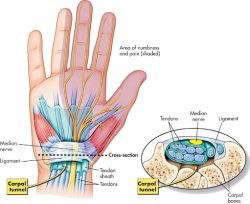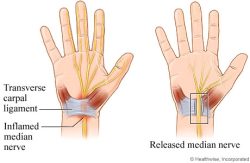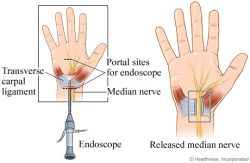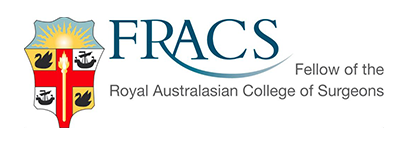Our hands take on a lot of day-to-day tasks, so when their mobility is restricted it can cause a number of problems. If you are experiencing issues with your hands or wrists, don’t suffer in silence. Our range of procedures can provide life changing relief from symptoms and help you move forward with confidence.
Carpal tunnel surgery, also known as carpal tunnel release, is a minimally invasive procedure to treat Carpal Tunnel Syndrome, a condition caused by excessive pressure on the median nerve in your wrist.
The syndrome was first described in the mid-1800s and affects women three times more than men. According to a PubMed paper, this condition affects nearly 390 million people worldwide, primarily aged 40 to 60 years. The carpal tunnel is a small inexpansible space in your wrist through which nine tendons and the median nerve pass on their way to the hand.
This median nerve helps you feel sensations in your thumb, index and middle fingers, and thumb-side-half of your ring finger.

A reduction in the size of this space may cause you to experience symptoms like:
Reductions can result from swelling of the nerve or tendons, fluid retention during pregnancy, arthritis, and injuries to the wrist. People whose jobs require repetitive hand movements, like pianists, typists, and factory workers, are at higher risk of developing carpal tunnel syndrome.
Although carpal tunnel release surgeries have existed since the 1930s, not all cases require surgery. Some non-surgical treatment options for carpal tunnel syndrome include:
In some advanced cases of carpal tunnel syndrome, these remedies may not suffice. You are likely to need carpal tunnel surgery if:
Carpal Tunnel Surgery helps relieve the pressure on the median nerve within the carpal tunnel. This release can be done using either of two types of procedures – open or endoscopic. Dr. Stewart and his team will work closely with you to develop a surgical plan and treatment options to offer you life-changing relief from your symptoms.
A surgeon makes a small cut on the palmar side of your wrist. Before an incision, you will be given sufficient anesthesia in your hand to numb the surgical field.

The surgeon then cuts the ligament enclosing the carpal tunnel, releasing your median nerve from the pressure causing your symptoms. The surgeon may further remove some tissues surrounding the nerve and create more space within the carpal tunnel. The area is stitched up after this and covered with a bandage.
The endoscopic carpal tunnel release is different, as the surgeon uses an endoscope after making two smaller cuts.
One cut is at the lower end of your palm and the other at the lower end of your wrist. The endoscope gives your surgeon a more sophisticated visualization of the carpal tunnel.
Together with other tools, the surgeon cuts through the carpal ligament to relieve the pressure on the median nerve. The endoscope is removed after relieving the pressure, and the incision is stitched and appropriately dressed. Dr Stewart prefers an open carpal tunnel release and can discuss the pros and cons of endoscopic release with you during your consultation.

With a success rate of more than 90%, there’s a lot you stand to gain from Carpal Tunnel Release Surgery.
There are certain risks associated with carpal tunnel release surgery, as with any procedure. In the hands of an experienced surgeon like Dr. Stewart, most of these complications are avoidable.
Seek medical attention immediately if, after the surgery, you begin to experience intense pain or symptoms of infection like fever and chills. Call your surgeon’s attention if the operated area swells up or has a discharge.
After the surgery, you will have to wear a bandage or a splint to protect your hand for two weeks and more. Full recovery and absolute pain relief may take at least one month.
Depending on how severe your symptoms were before the surgery, the carpal tunnel release surgery may take away all or part of your symptoms. Some people regain grip and pinch strength 2 to 3 months after surgery. However, some others take between 6 to 12 months before noticing any changes.
Carpal Tunnel Syndrome could sometimes be debilitating. If you’re experiencing any symptoms or have been diagnosed with the condition, getting an expert opinion is the next best step for you. Dr. Nathan Stewart is a fellow of the Royal Australasian College of Surgeons [FRACS] in Plastic and Reconstructive Surgery and a Consultant Specialist Plastic Surgeon. Contact Dr. Stewart and his team today to schedule an appointment.
Affiliations




After the carpal tunnel surgery, you will have to wear a bandage or a splint to protect your hand for two weeks and more. Full recovery and absolute pain relief may take at least one month.
Depending on how severe your symptoms were before the surgery, the carpal tunnel release surgery may take away all or part of your symptoms. Some people regain grip and pinch strength 2 to 3 months after surgery. However, some others take between 6 to 12 months before noticing any changes.